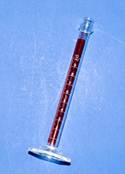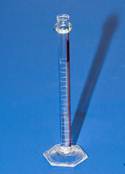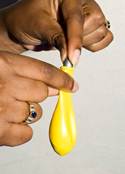
|
Collect 2 unknown metal objects to investigate
In your lab notebook, make close observations about the markings, color and condition of the unknowns. |

|
Use a standard weighing technique to weigh the metal unknowns on the analytical balance provided. Be sure to wipe the objects with Kimwipes to remove any fingerprints, etc. Record both masses in your lab notebook. |

|
Use the appropriate method, volume by displacement or volume by measurement, to find the volume of your object. Be sure to note the method you chose and the reasons for your decision.
Using the density values you calculated in your pre-laboratory assignment, determine the identities of your two unknown metal objects. |
Part II Building a Submarine |

|
Weigh a 10 mL graduated cylinder using a standard weighing technique. Be sure to wipe it with Kimwipes to remove any fingerprints, etc. Record the mass in your lab notebook.
|

|
Use a disposable pipette to collect ~1-4 mL of "ocean" water from the reservoir provided. Transfer the “ocean” sample to the weighed graduated cylinder. Record the exact volume to 0.01 mL in your lab notebook. |

|
Re-weigh the graduated cylinder with the water in it using a standard weighing technique. Be sure to wipe it with Kimwipes to remove any fingerprints, etc. Record the total mass in your lab notebook. |

|
Collect a balloon and 20 metal pellets from your instructor. Weigh the balloon and pellets using a standard weighing technique. Be sure to wipe them with Kimwipes to remove any fingerprints, etc. Record the total mass in your lab notebook. |

|
Carefully place the pellets inside the balloon. |

|
Using the calculated density of the "Ocean" water and the equation given in the background section calculate the diameter of the balloon needed to equal that density. Blow up your balloon to this diameter and seal it. (Note: Although the balloons should be round, they are often more elliptical in shape. Squeeze the balloon into a round shape as you measure it with your calipers for the best result.) |

|
Test the viability of your "submarine" by placing it in the "Ocean". A good submarine will neither sink nor float but rather hover just below the surface. Make notes in your lab notebook describing the results of this test. |